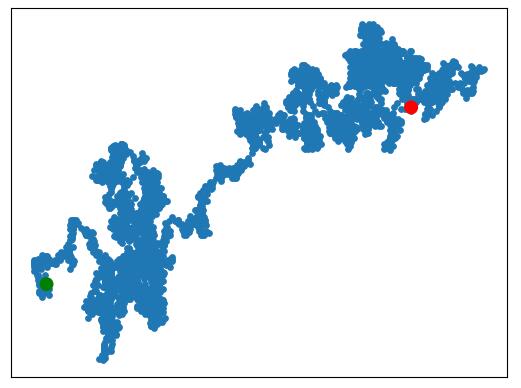Python中的os.path路径模块中的操作方法总结
解析路径
路径解析依赖与os中定义的一些变量:
- os.sep-路径各部分之间的分隔符。
- os.extsep-文件名与文件扩展名之间的分隔符。
- os.pardir-路径中表示目录树上一级的部分。
- os.curdir-路径中当前目录的部分。
split()函数将路径分解为两个单独的部分,并返回包含这些结果的tuple。第二个元素是路径的最后部分,地一个元素是其他部分。
import os.path
for path in [ '/one/two/three',
'/one/two/three/',
'/',
'.',
'']:
print '%15s : %s' % (path, os.path.split(path))
输入参数以os.sep结尾时,最后一个元素是空串。
输出:
/one/two/three : ('/one/two', 'three')
/one/two/three/ : ('/one/two/three', '')
/ : ('/', '')
. : ('', '.')
: ('', '')
basename()函数返回的值等价与split()值的第二部分。
import os.path
for path in [ '/one/two/three',
'/one/two/three/',
'/',
'.',
'']:
print '%15s : %s' % (path, os.path.basename(path))
整个路径会剥除到只剩下最后一个元素。
输出:
/one/two/three : three
/one/two/three/ :
/ :
. : .
:
dirname()函数返回分解路径得到的第一部分。
import os.path
for path in [ '/one/two/three',
'/one/two/three/',
'/',
'.',
'']:
print '%15s : %s' % (path, os.path.dirname(path))
将basename()与dirname()结合,得到原来的路径。
/one/two/three : /one/two
/one/two/three/ : /one/two/three
/ : /
. :
:
splitext()作用类似与split(),不过它会根据扩展名分隔符而不是目录分隔符来分解路径。import os.path
for path in [ '/one.txt',
'/one/two/three.txt',
'/',
'.',
''
'two.tar.gz']:
print '%21s : %s' % (path, os.path.splitext(path))
查找扩展名时,只使用os.extsep的最后一次出现。
/one.txt : ('/one', '.txt')
/one/two/three.txt : ('/one/two/three', '.txt')
/ : ('/', '')
. : ('.', '')
two.tar.gz : ('two.tar', '.gz')
commonprefix()取一个路径列表作为参数,返回一个字符串,表示所有路径中出现的公共前缀。
import os.path
paths = [ '/one/two/three',
'/one/two/threetxt',
'/one/two/three/four',]
for path in paths:
print 'PATH:', path
print
print 'PREFIX:', os.path.commonprefix(paths)
输出:
PATH: /one/two/three PATH: /one/two/threetxt PATH: /one/two/three/four PREFIX: /one/two/three
建立路径
除了分解现有路径外,还需要从其他字符串建立路径,使用join()。
import os.path
for parts in [ ('one', 'two', 'three'),
('\one', 'two', 'three'),
('/one', '/two', '/three', '/four'),]:
print parts, ':', os.path.join(*parts)
如果要连接的某个参数以os.sep开头,前面所有参数都会丢弃,参数会返回值的开始部分。
('one', 'two', 'three') : one\two\three
('\\one', 'two', 'three') : \one\two\three
('/one', '/two', '/three', '/four') : /four
规范化路径
使用join()或利用嵌入变量由单独的字符串组合路径时,得到的路径最后可能会有多余的分隔符或者相对路径部分,使用normpath()可以清除这些内容。
import os.path
for path in [ 'one/two/three',
'one/./two/three',
'one/../alt/two/three',
]:
print '%20s : %s' % (path, os.path.normpath(path))
可以计算并压缩有os.curdir和os.pardir构成的路径段。
one/two/three : one\two\three
one/./two/three : one\two\three
one/../alt/two/three : alt\two\three
要把一个相对路径转换为一个绝对文件名,可以使用abspath()。
import os.path
for path in [ '.',
'..',
'one/two/three',
'one/./two/three',
'one/../alt/two/three',
]:
print '%20s : %s' % (path, os.path.abspath(path))
结果是从一个文件系统树最顶层开始的完整路径。
. : C:\Users\Administrator\Desktop
.. : C:\Users\Administrator
one/two/three : C:\Users\Administrator\Desktop\one\two\three
one/./two/three : C:\Users\Administrator\Desktop\one\two\three
one/../alt/two/three : C:\Users\Administrator\Desktop\alt\two\three
文件时间
import os import time print 'File:', __file__ print 'Access time:', time.ctime(os.path.getatime(__file__)) print 'Modified time:', time.ctime(os.path.getmtime(__file__)) print 'Change time:', time.ctime(os.path.getctime(__time__)) print 'Size:', os.path.getsize(__file__)
返回访问时间,修改时间,创建时间,文件中的数据量。
测试文件
程序遇到一个路径名,通常需要知道这个路径的一些信息。
import os.path filename = r'C:\Users\Administrator\Desktop\tmp' print 'File :', filename print 'Is file? :', os.path.isfile(filename) print 'Absoulute :', os.path.isabs(filename) print 'Is dir? :', os.path.isdir(filename) print 'Is link? :', os.path.islink(filename) print 'Mountpoint? :', os.path.ismount(filename) print 'Exists? :', os.path.exists(filename) print 'Link Exists? :', os.path.lexists(filename)
所有测试都返回布尔值。
File : C:\Users\Administrator\Desktop\tmp Is file? : False Absoulute : True Is dir? : True Is link? : False Mountpoint? : False Exists? : True Link Exists? : True
遍历一个目录树
import os
import os.path
import pprint
def visit(arg, dirname, names):
print dirname, arg
for name in names:
subname = os.path.join(dirname, name)
if os.path.isdir(subname):
print '%s/' % name
else:
print ' %s' % name
print
if not os.path.exists('example'):
os.mkdir('example')
if not os.path.exists('example/one'):
os.mkdir('example/one')
with open('example/one/file.txt', 'wt') as f:
f.write('i love you')
with open('example/one/another.txt', 'wt') as f:
f.write('i love you, two')
os.path.walk('example', visit, '(User data)')
会生成一个递归的目录列表。
example (User data) one/ example\one (User data) another.txt file.txt
一些实际的用法合集:
#创建文件:
os.mknod("test.txt") 创建空文件
fp = open("test.txt",w) 直接打开一个文件,如果文件不存在则创建文件
#获取扩展名:
>>> os.path.splitext('/Volumes/Leopard/Users/Caroline/Desktop/1.mp4')[1:]
('.mp4',)
>>> os.path.splitext('/Volumes/Leopard/Users/Caroline/Desktop/1.mp4')[1]
'.mp4'
#获取文件名:
>>> print os.path.basename(r'/root/hahaha/123.txt')
123.txt
>>> print os.path.dirname(r'/root/hahaha/123.txt')
/root/hahaha
#判断目录或文件的存在:
>>> os.path.exists('/root/1.py')
True
>>> os.path.exists('/root/')
True
>>> os.path.exists('/root')
True
>>> os.path.isdir('/root')
True
#改变工作目录:
>>> os.chdir('/home')
>>> os.getcwd()
'/home'
#字符串分割:
>>> '/usr/bin/env'.split('/')
['', 'usr', 'bin', 'env']
#获取文件夹大小(Python2.x):
import os
from os.path import join, getsize
def getdirsize(dir):
size = 0L
for root, dirs, files in os.walk(dir):
size += sum([getsize(join(root, name)) for name in files])
return size
if __name__ == '__main__':
filesize = getdirsize('/tmp')
print 'There are %.3f' % (filesize/1024/1024), 'Mbytes in /tmp'
#获取文件夹大小(Python3.x):
import os
from os.path import join, getsize
def getdirsize(dir):
size = 0
for root, dirs, files in os.walk(dir):
size += sum([getsize(join(root, name)) for name in files])
return size
if __name__ == '__main__':
filesize = getdirsize('/tmp')
print ('There are ' + str(filesize/1024/1024) + 'Mbytes in /tmp')



